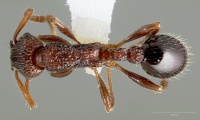Myrmica punctinops
| Myrmica punctinops | |
|---|---|

| |
| Scientific classification | |
| Kingdom: | Animalia |
| Phylum: | Arthropoda |
| Class: | Insecta |
| Order: | Hymenoptera |
| Family: | Formicidae |
| Subfamily: | Myrmicinae |
| Tribe: | Myrmicini |
| Genus: | Myrmica |
| Species: | M. punctinops |
| Binomial name | |
| Myrmica punctinops Francoeur, 2007 | |
Francoeur (2007) - The species was found at 44 m and 1615 m altitude. Specimens from Charlton Flat were sifted from oak and pine forest litter. Those from Fort Ord were found in a kind of maritime chaparral on sand, dominated by the rare species Arctostaphylos pumila, with a mixture of thermophilic and cold-tolerant ant species (P.S. Ward, pers. comm.).
Identification
A member of the punctiventris group.
Keys including this Species
Distribution
Endemic to California.
Latitudinal Distribution Pattern
Latitudinal Range: 36.68333° to 33.34°.
| North Temperate |
North Subtropical |
Tropical | South Subtropical |
South Temperate |
- Source: AntMaps
Distribution based on Regional Taxon Lists
Nearctic Region: United States (type locality).
Distribution based on AntMaps
Distribution based on AntWeb specimens
Check data from AntWeb
Countries Occupied
| Number of countries occupied by this species based on AntWiki Regional Taxon Lists. In general, fewer countries occupied indicates a narrower range, while more countries indicates a more widespread species. |

|
Estimated Abundance
| Relative abundance based on number of AntMaps records per species (this species within the purple bar). Fewer records (to the left) indicates a less abundant/encountered species while more records (to the right) indicates more abundant/encountered species. |

|
Biology
Castes
Known only from the worker types.
Nomenclature
The following information is derived from Barry Bolton's Online Catalogue of the Ants of the World.
- punctinops. Myrmica punctinops Francoeur, 2007: 163, figs. 20 27 (w.) U.S.A.
Unless otherwise noted the text for the remainder of this section is reported from the publication that includes the original description.
Description
Worker
Head in full face view subrectangular with convex sides; preoccipital margin straight and corners largely rounded. Eyes small, convex and suboval, located slightly anteriorly of the mid point of the head sides. Anterior margin of clypeus angulo-convex; lateral wings thin and flat, with 1-3 starting genal carinae. In dorsal view frontal lamellae large, laterally developed over the antennal articulation, triangular in shape with a rounded angle; posterior margin narrower and ending as a carinae merging into the head dorsum. Antennae: fossae rather shallow; scapes shorter than head length and width; in profile base evently bent, dorso-ventrally flattened with a feeble dorsal concavity; in dorsal view shaft width regular along its axis. Funiculus segments 3-5 as large as long, other longer than broad; apical club of 4 segments.
Mesosoma in profile, mesometasternum external margin horizontally aligned, promesonotum very feebly convex, almost straight in larger specimens, distinctly higher than propodeum, both joining through an angle at the mesopropodeal furrow which remains shallow. In dorsal view promesonotum typically pear-like, posterior end of narrower and angulo-convex. Strigil of protibia with a basal tooth; meso and metatibiae with delicate spurs, finely and shortly pectinate on the distal half. Propodeal lobes small, with a posterodorsal angle. Propodeal spines straight and acuminate, rather short and thin, with a narrow base, shorter than the distance separating their tips, projecting backwards and upwards at 45°, usually parallel; in dorsal view a feeble recurvation after the base often present. Petiole short, about as high as long but narrower; peduncle hidden by propodeal lobes; node seen in profile anterior face slightly concave, forming a right angle with the dorsal surface which is rather flattened, follow another angle with the concave posterior face, inclined down to the posterior margin. Postpetiole shorter than high and wide, the latters about equal; node profile typically with very short anterior and posterior vertical of the postpetiole height.
Mandibles striated with ciliated punctures. Frons and clypeus with parallel, acute and thin carinae, widely separated by subopaque, faintly microsculptured surface; reminder of head with reticulation. Mesosoma generally striato-rugulose; carinae thicker on pleurae and somewhat sinuous on promesonotum. Antennal fossae with parallel and convex carinae. Petiole and postpetiole rugose. Gaster smooth and shining; first segment with large rounded punctures. Long and erect hairs moderately abundant on body; suberect on scape. Gastric dorsum without distinct pubescence. General body color light to dark reddish brown; gaster darker; appendages lighter or more yellowish.
Type Material
Holotype worker and 17 worker paratypes: USA, Charlton Flat, San Gabriel Mountains, Los Angeles Co., California, U.S.A., 25.v.2002 (R. R. & G. C. Snelling). Additional paratypes: 1 worker, same locality, 18.vi.1944 (collector unknown); 2 workers, Brown’s Flat, San Gabriel Mountains, Los Angeles Co., 3.xi.1960 (E.L. Sleeper); 2 workers, Fort Ord, UCSC Reserve, Monterey Co., 5.xi.1998 (L. DiGirolamo). Holotype and most paratypes in Los Angeles County Museum of Natural History; paratypes also in CAFR, Museum of Comparative Zoology, and University of California, Davis.
References
- Francoeur, A. 2007. The Myrmica punctiventris and M. crassirugis species groups in the Nearctic region. Pages 153-186 in R. R. Snelling, B. L. Fisher, and P. S. Ward, editors. Advances in ant systematics (Hymenoptera: Formicidae): homage to E. O. Wilson - 50 years of contributions. Memoirs of the American Entomological Institute, vol. 80, Gainesville, FL, 690 p.
References based on Global Ant Biodiversity Informatics
- Des Lauriers J., and D. Ikeda. 2017. The ants (Hymenoptera: Formicidae) of the San Gabriel Mountains of Southern California, USA with an annotated list. In: Reynolds R. E. (Ed.) Desert Studies Symposium. California State University Desert Studies Consortium, 342 pp. Pages 264-277.
- Francoeur A. 2007. The Myrmica punctiventris and M. crassirugis species groups in the Nearctic region. Memoirs of the American Entomological Institute 80: 153-185.

